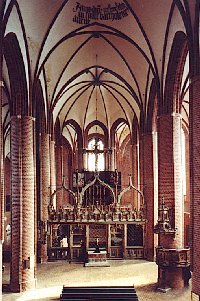 The church of Mary, also referred to as the Town Church, belongs to the late Gothic Hall Churches. One finds these churches very often in northern Germany.
The church of Mary, also referred to as the Town Church, belongs to the late Gothic Hall Churches. One finds these churches very often in northern Germany.
The engraving in the middle of the church ceiling states the church opened on St. Bartholomew’s day, August, 24, 1447.
The present Marien Church is not the first building. At this place stood earlier a small church in the romanesque style. In the Middle Ages, when Stendal was growing, this church became too small, so it was torn down and a new church was built with the theme "higher and lager".
The view of the inner room is impressive, particularly if viewed from the organ balcony. The secret of the impressive beauty of that wonderful room lies in the harmony of the dimensions, and the simpleness of each element, without excessive details to confuse and divert.
 Around the churchs interior one can see apsidial and lateral chapels, 26 in all, which, during the Catholic period, were devoted to the Saints. In Protestant times, since 1538, these chapels were used as family vaults.
Around the churchs interior one can see apsidial and lateral chapels, 26 in all, which, during the Catholic period, were devoted to the Saints. In Protestant times, since 1538, these chapels were used as family vaults.
In the south-west corner of the church is found the only large separate room of the church, a chapel, which served in Catholic times for the worship of the Virgin Mary. In the entry of this chapel is found the tombstone of the first protestant pastor of this church. In the centre of this chapel stand’s a bronze baptismal font, dating from 1474.
Moving to the front of the church, one sees the Renaissance pulpit, which was created in the year 1566. On the exterior of this pulpit we can see men of the Bible. Particularly interesting is the figure of Jesus, holding the globe in his hand. Painted on this globe is the oldest known view of Stendal.
In the eastern part of the church is the altar screen, which separates the apse from the nave. Above, in the middle of the divider, one can see Mary with Jesus. The Twelve Apostels stand, six to the left and six to thr right, representations presumed to date from 1220.
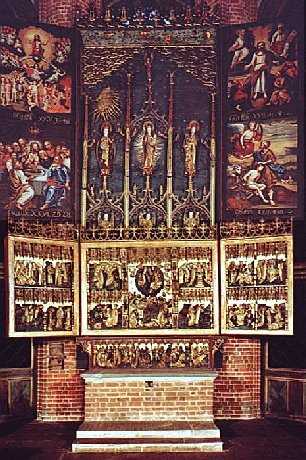
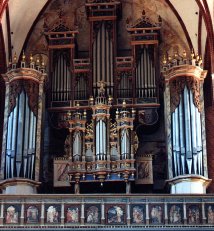 Entering the sanctuary, we see the High Altar, a triptych, with carvings of the highest artistic quality. Created by an unknown artist around 1470, it was dedicated to the Virgin Mary. We see her in the center of a radiating circle. The lower wings, to the left and right, show scenes of the childhood of Jesus, with Mary as the central figure.
Entering the sanctuary, we see the High Altar, a triptych, with carvings of the highest artistic quality. Created by an unknown artist around 1470, it was dedicated to the Virgin Mary. We see her in the center of a radiating circle. The lower wings, to the left and right, show scenes of the childhood of Jesus, with Mary as the central figure.
The two painted panels above the right and left date from the time after the Reformation, 1581, and depict Biblical scenes with Protestant content. The intention was to make the altar with its Catholic accent more acceptable to the Protestant conscience.
As we leave the sanctuary, the view is towards the organ, which is positioned on the balcony. This instrument dates from the year 1580 and was built by Scherer (Hamburg). It has had alterations over the years on 45 different occassions. The last was that from 1941-43 with the building of two pedal towers in the neo-Baroque style to the left and to the right.
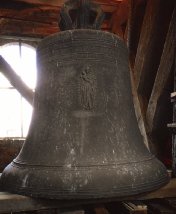 The ringing of the four bells produces a marvellous sound. The largest bell called "Maria" has a diameter of two meters and weighs around 5400 kilograms.
The ringing of the four bells produces a marvellous sound. The largest bell called "Maria" has a diameter of two meters and weighs around 5400 kilograms.
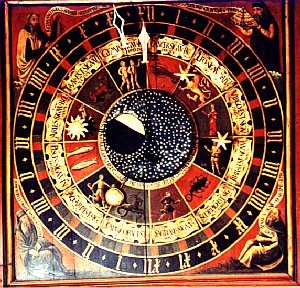 Under the organ balcony is the astronomical clock, dating of 1580, which was restored to a functioning condition in 1977. It has a 24 hour dial. On the outside of the dial are the signs of the zodiac, symbols of the twelve months of the year. The hand that depicts the sun always points to the current month.
Under the organ balcony is the astronomical clock, dating of 1580, which was restored to a functioning condition in 1977. It has a 24 hour dial. On the outside of the dial are the signs of the zodiac, symbols of the twelve months of the year. The hand that depicts the sun always points to the current month.
The moon, depicted as a golden crescent, shows its position to the sun in its current phase. For example, if the moon is positioned directly under the sun, and therewith is covered by the sun, that indicates the phase of the NEW MOON. If the moon is to the right of the sun, it is the Waxing Moon. If it is opposite to the sun, we have Full Moon. If it is to the left of the sun, it is Waning Moon.
The two stars, which are counterweights to the moon and the sun, are planets whose meaning has not been discovered so far.

